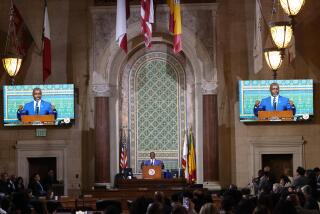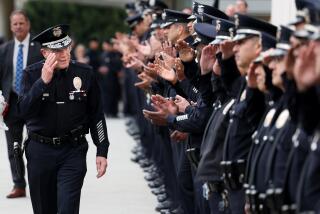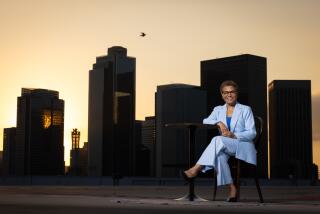Three Leaders Left in the Lurch
By coincidence, three of Los Angeles’ most powerful leaders find themselves in trouble at the same time, caught in a tide of history that would challenge even the most skilled politician.
When the L.A. region was a simpler place, Mayor James K. Hahn might have escaped heavy criticism for his ungainly move against LAPD Chief Bernard C. Parks. Parks would not have been harassed by disclosures of police brutality at one of his department’s divisions, because such conduct was seldom reported. And Cardinal Roger M. Mahony would not have had to deal with both a skeptical press and parishioners concerned about the cover-up of priestly child molestation.
That was the L.A. of 40 years ago. The city and its suburbs were more stable. It was before powerful social, demographic and economic forces ripped through them, before they were covered by skeptical journalists with a taste for blood and a medium, television, that has exceeded the influence of the press lords of an earlier day.
The demands on leadership have become much greater in a place now divided by many ethnic groups, by extremes in economic class and by geographical breakaway movements in the San Fernando Valley, Hollywood and the harbor area. Parks, Hahn and Mahony have responded to the city’s plethora of narrow constituencies in his own way. The question is whether their leadership styles have met the challenge of the new L.A.
Ten years ago, on the first night of rioting, Mayor Tom Bradley led civic powers at a meeting at the First African Methodist Episcopal Church designed to calm the community. This was the old L.A. way--the empowered, operating top-down, urging calm.
It didn’t work. The words of Bradley, who once had a perfect sense of L.A.’s changing currents, and of other older black leaders went unheeded. Soon after the meeting broke up, fires moved up from West Adams Boulevard toward the church, consuming apartment houses around it. I watched African American men from the church and Latino men from the apartments fight the fires with garden hoses, with no police or firefighters in sight.
Los Angeles had changed in ways that we are still trying to comprehend. Fighting a fire was easy. African Americans and Latinos looting stores was harder to deal with.
In the new divided L.A., a leader can only succeed by having the intangible attributes of being both a symbol and a communicator. All that, plus the ability to connect with homeowner groups and other neighborhood and grass-roots organizations--small but critical links that hold L.A. together.
We want our leaders from the streets and neighborhoods, not from City Hall. Compare Parks with one of his most successful predecessors, Ed Davis.
Parks is all City Hall, a top-down manager who lectures rather than listens. He expresses himself in the heavy language of the City Hall bureaucrat, even when he talks to neighborhood groups. From the beginning of his tenure, he scorned community policing, a popular program that made residents feel as though they had their own small-town police department. His words and actions against community policing made him a symbol of a city government that didn’t care.
Davis, on the other hand, was all street, with a brilliant sense of communication, symbolism and politics. He cultivated his reputation as a rough law-and-order cop. His fierce and colorful attacks on politicians and The Times--among cops’ least-favorite institutions--was seen by the police as a symbol of stubborn LAPD independence.
But it was Davis who created community policing, and he cemented his ties with neighborhoods even more by organizing police-support block clubs in every part of the city.
Hahn actually is from the neighborhoods, living in a middle-class area of San Pedro. But like Parks, he has overdosed on the set ways of City Hall, talking as though he were a bland department head in fear of being overruled by the boss. After he moved against Parks, Hahn exhibited a defensiveness reminiscent of a middle-level executive worried about getting a poor performance report.
Hahn doesn’t seem to realize that he is the boss, with the power to be more of a boss than any previous mayor. That’s because the new City Charter gives him unprecedented power.
His immediate predecessors--Richard Riordan, Bradley and Sam Yorty--had less legal power, but much more actual clout because they understood what it takes to lead L.A.
Riordan defined his mayoralty by a single act of governance and symbolism--driving to the city’s emergency headquarters on the morning of the 1994 Northridge earthquake, and taking charge. He communicated to the city that he was the boss, no matter what the charter said about his power. The image of boss was reinforced by his campaigns for a new charter and for a new school board.
Yorty was the first of L.A.’s modern media politicians. He was elected mayor despite the opposition of the great media powers of the time, the city’s newspapers. He brushed aside the newspapers and went on television, both with advertising and news shows--in the days when TV actually covered politics.
Yorty became the symbol of the scrappy little guy--especially the Valley guy--against City Hall, although he occupied the place for three terms. In a simpler city, he was able to hold the loyalty of a constituency that was predominantly white and largely centered in the San Fernando Valley. He withstood the 1965 Watts riots, fueled by years of anger against the Police Department, and emerged strong enough to beat Bradley in 1969 by playing the race card long before the tactic became popular.
For the next four years, Bradley tirelessly worked the same neighborhoods, building his strength in the West Side, the Valley, the harbor area, South L.A. and the Eastside, campaigning among whites, blacks, Latinos, and among every economic class. He was the first politician to acknowledge the importance of the city’s growing Asian population.
Bradley became the mayor of all the people, for most of his reign a comforting symbol of unity, a feeling best expressed during the 1984 Summer Olympic Games in Los Angeles.
Mahony seems to understand the dynamics of leadership here. He can be as hot-tempered as Davis, as vindictive as Yorty, as impetuous as Riordan. But when he campaigned against anti-immigrant measures in 1994 on the California ballot, he was, like Bradley, a symbol of inclusion.
At first, Mahony fumbled his way in dealing with the church’s sexual-abuse scandal, refusing to reveal how many priests had been dismissed for past offenses. But then he regained his footing.
Mahony invited television and news-radio reporters to his new cathedral for short one-on-one interviews, where he was pleasant, if not forthcoming. In the days that followed, he used the media to transform himself from suspected co-conspirator in a priestly cover-up to dedicated reformer. That’s how he appeared on the “NewsHour with Jim Lehrer” last week talking about the American cardinals meeting with Pope John Paul II at the Vatican.
The tide of history has already claimed Parks. Hahn is struggling offshore, hoping a lifeguard can reach him in time. Only Mahony is still afloat. He alone of the three understands the politics and currents of the new L.A.
More to Read
Sign up for Essential California
The most important California stories and recommendations in your inbox every morning.
You may occasionally receive promotional content from the Los Angeles Times.









